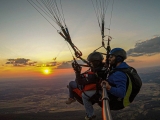
At 91 years old, he’s full of dreams, still marvelling at the underwater world as much as the first time he put on a diving mask, and among his fish friends, he feels right at home.
Don’t miss the story of one of the living legends of Spanish diving.

Yumping.- Eduard, you’ve been dedicated to diving for nearly 67 years. How do you remember the early days?
Eduard Admetlla.- As one of the most beautiful stages of my life. It’s rare to discover a whole new world—you think everything’s already been explored—but then, one day, I put on a mask and saw the seabed. Back then, very few people had diving goggles; it was uncharted territory.
For me, it was a new world I never left. I’ve been part of it since I was 24, and to this day, I’m still diving.
Those early days were thrilling. There was no equipment; you had to invent everything yourself and make do: masks, snorkels... I’d figure out what I needed and craft it myself because back then, there was nothing.

Y.- Back then, this sport was perhaps reserved for only a handful. Equipment has improved, new destinations have been discovered, and almost everyone’s had some contact with diving... What’s your take on diving today?
E.A.- Back then, it was an unknown, mysterious speciality, shrouded in an aura of high risk, but now it’s become a mass sport. Every week, I go to the Medes Islands, a marine reserve, and there’s a crowd of divers—it’s excessive, too well-known... Even 7-year-olds have diving gear now, which was unthinkable before.
The aura of risk has partly faded. There are courses that teach you everything, not just techniques but also rules and standards—though, admittedly, these aren’t always followed.
It’s great that diving is more accessible, but perhaps the downside is how many people do it. I’ve seen queues, centres sending boats out in shifts... At some point, you think: is this the wrong path?

Y.- You’re none other than the inventor of waterproof housings for underwater cameras, and you designed the autonomous diving suit, a variation of the one created by Cousteau-Gagnan. How did you decide to take that step?
E.A.- It was a real odyssey. I had the chance to try the diving suit from France—to breathe underwater for the first time (I came from freediving)—and when I realised I could breathe, I said: I want my own suit! So I designed it, patented the invention, and created it.
It was an odyssey. I scavenged materials everywhere—one day at 3 a.m., I even took the curtain rod! Of course, when my wife saw it the next day... (laughs). But I had no idea where to find materials to build the gear.
I even went to a company that made fire extinguishers at the time. We filled one with compressed air, I took a household gas regulator, and bit by bit, I assembled it. I dove with a fire extinguisher setup! In the end, I managed to reach 50 metres—all handmade.

The patent took off, went commercial... and now there are options for every taste: aluminium, steel, green rubber suits, yellow ones... (laughs).
Y.- And as if that weren’t enough, you were the first diver to reach 100 metres deep using compressed air tanks, even at the risk of not surviving to tell the tale. What did that mean to you?
E.A.- It was hugely significant, not just for me but for diving itself, because it marked the start of deep-sea diving as a pursuit. There were precedents—Cousteau tried it first but only reached 90 metres; an American also attempted it and even surpassed 100 metres... but didn’t resurface. I was the third man.
I wanted to do a proper, verifiable dive, so I went to Cartagena, to the navy divers’ school, to have it certified—and it all went perfectly.
That feat was the push diving needed to start evolving.

Y.- Another of your great passions is underwater film and photography. How did you get into that world?
E.A.- A pioneer is someone who sees what no one else has yet. So at the time, I wanted to explain what lay beneath the sea—I’d tell people, but I noticed that while they understood, they wanted to *see* it.
That’s when I started taking photos and videos. Years later, I got involved with television and spent 15 years producing underwater documentary series with Spanish TV.
Back then, I had a high-profile job as an executive at a major company. But TVE approached me with the project; at 50, I took a leave of absence to film the series and started doing what I loved. That said, it was work—not easy. If TVE didn’t accept your footage, you were out. It demanded full dedication; no holidays. You signed a contract and delivered—and that’s what I did.

Everyone told me I was mad to abandon my career, even my wife, but I remember it as the best time of my life, when I had the most fun. If I hadn’t done it then, I never would have.
It was magical. I’d pick a destination, submit a budget to TV, they’d approve it, and we’d gather a team of expert divers.
We went wherever we wanted to do what we loved most... like playing poker knowing you’ll win (laughs). For those years, I could dive and film full-time—it was incredible.
Y.- What did you want to convey through your work?
E.A.- How beautiful and fascinating it all was—so others could see what I saw. Many people grew curious about the seabed, and I became obsessed with sharing that experience.
Some call me the


















